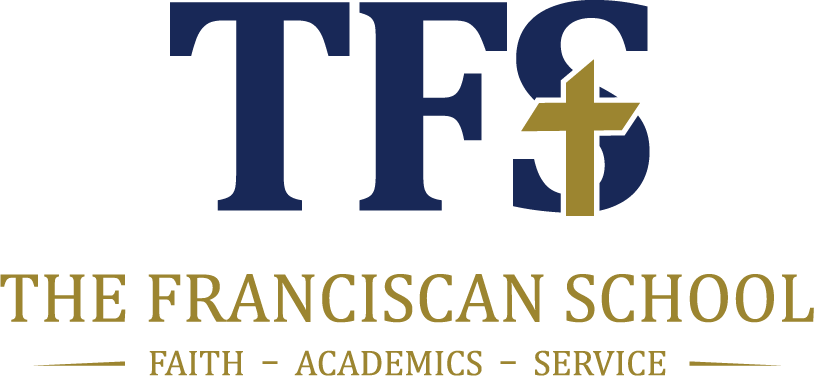“Catechesis aims to bring about in the believer an ever more mature faith in Jesus Christ, a deeper knowledge and love of his person and message, and a firm commitment to follow him.” (National Directory of Catechesis, No. 19)
At TFS, the Religion curriculum serves as the framework for religious instruction. The goal is to assist all students in growing in an understanding of their faith as Roman Catholics and deepening their relationship with Jesus Christ. Through intentional integration, faith becomes a lived experience for students, shaping their hearts and minds as they become compassionate, thoughtful, and faithful.
Beginning in Kindergarten through eighth grade, the Diocesan Religion curriculum has six fundamental tasks: Knowledge of Faith, Liturgical Education, Moral Education, Teaching to Pray, Education for Community Life, and Missionary Initiation.
Iris Lacson, third-grade teacher, shares that in her class, they cover various topics, including God's Love, The Trinity, Jesus Christ, The Church, Morality, and Sacraments. “The students love hearing how what we cover in Religion relates to what happens to them in real life,” shares Mrs. Lacson. “For example, when we get to our topic on Morality about Choosing Love, we discuss how, as part of choosing to love, we forgive our siblings even if they do something that annoys us. That lesson always gets so much student participation because many can relate to that situation.”
In 5th grade, the focus is on the sacraments and Mass, with a special emphasis on the gift of the Eucharist. The sixth-grade curriculum is focused on the Old Testament and God’s faithfulness and love throughout salvation history. Ed Manville, a religion teacher for these grades, has always been active in his parish and has participated in mission trips to serve the poor. Before TFS, he taught theology at Cardinal Gibbons (CGHS) and high school in the Wake County Public School System. “There is no greater privilege than sharing the gift of our Catholic faith with youth,” says Mr. Harmon. “I see this as part of my vocation, a way of fulfilling the mission God has given me.”
In fifth and sixth grade, every class begins by praying in the back of the classroom, a dedicated prayer space. A child-friendly meditation (often a reflection on Scripture or a saint) is read. Intercessory prayers are often shared, or a praise and worship song is played. This year, in collaboration with Tom Harmon (the seventh and eighth religion teacher), all sixth graders have a prayer journal that they carry with them through their middle school years at TFS. Sixth, seventh & eighth-grade students will also participate in annual retreats created for their respective grade levels led by a team at CGHS.
Mr. Harmon, now in his eighth year at TFS, is a religion teacher for the 7th and 8th grades. In the 7th grade, the primary focus is on the New Testament, starting with Jesus’ historical and Jewish background and discovering how the context of the Gospels illuminates the foundation of our Catholic faith. This class integrates a personal relationship with Jesus through the Sacraments and our love of neighbor, as illustrated by TFS’ monthly Catholic Social Teaching projects.
In 8th grade, the attention is primarily on Church history, beginning with the birth of the Church at Pentecost through Acts of the Apostles. Highlights of the past 2,000 years of Church history are explored, discovering the guidance of the Holy Spirit through the ‘thick and thin’ of Church history.
Mr. Harmon shares, “The middle school students are engaged through discussion groups, assignments, and projects, expanding their application of classroom instruction to apply creative and concrete projects.”
The Franciscan School strives to create a faith-filled environment that draws each community member closer to Christ. Principal Dawn Smith shares, “Not only can the Franciscan values of humility, care for creation, and love for all people guide prayer and worship, but also how students interact with one another, approach learning, and see their role in society.”
Recent Posts
Archives
- September 2019 (4)
- August 2020 (3)
- January 2021 (3)
- August 2021 (3)
- January 2022 (3)
- August 2022 (3)
- January 2023 (3)
- June 2023 (3)
- January 2024 (3)
- May 2024 (3)
- October 2024 (3)
- December 2024 (3)
- October 2019 (2)
- February 2020 (2)
- March 2020 (2)
- April 2020 (2)
- May 2020 (2)
- July 2020 (2)
- September 2020 (2)
- October 2020 (2)
- November 2020 (2)
- December 2020 (2)
- February 2021 (2)
- March 2021 (2)
- April 2021 (2)
- May 2021 (2)
- June 2021 (2)
- July 2021 (2)
- September 2021 (2)
- October 2021 (2)
- November 2021 (2)
- December 2021 (2)
- February 2022 (2)
- March 2022 (2)
- May 2022 (2)
- June 2022 (2)
- July 2022 (2)
- September 2022 (2)
- October 2022 (2)
- November 2022 (2)
- February 2023 (2)
- March 2023 (2)
- April 2023 (2)
- May 2023 (2)
- July 2023 (2)
- August 2023 (2)
- September 2023 (2)
- October 2023 (2)
- November 2023 (2)
- December 2023 (2)
- February 2024 (2)
- March 2024 (2)
- April 2024 (2)
- June 2024 (2)
- July 2024 (2)
- August 2024 (2)
- September 2024 (2)
- January 2025 (2)
- February 2025 (2)
- March 2025 (2)
- April 2025 (2)
- July 2019 (1)
- August 2019 (1)
- November 2019 (1)
- December 2019 (1)
- January 2020 (1)
- June 2020 (1)
- April 2022 (1)
- December 2022 (1)
- November 2024 (1)

Leave a Reply